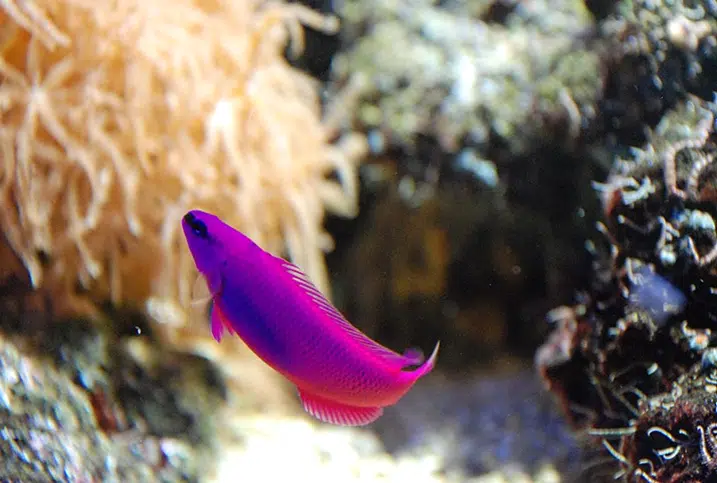Welcome to this article about the 10 most exciting purple animals.
Think of a purple animal; what’s the animal that comes to mind? None, right? Exactly! Purple is a rare color in nature because plants and animals cannot always produce pigments for the color. It’s this rarity, perhaps, that makes purple a color associated with royalty.
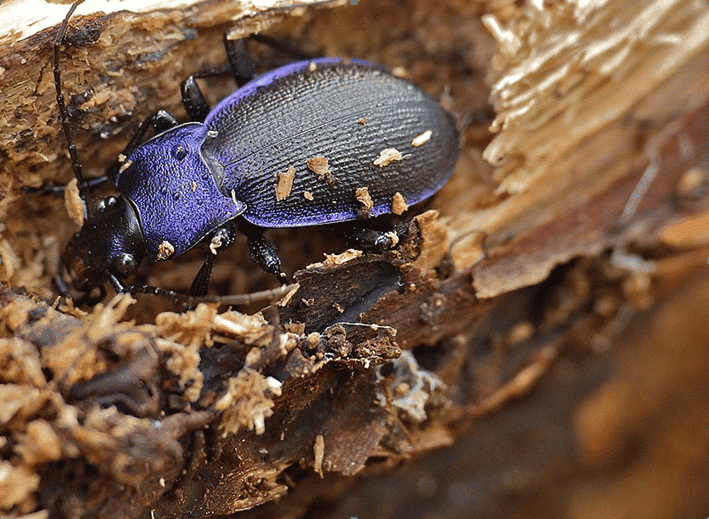
The fact that the color is rare in nature doesn’t mean it doesn’t exist. You must have seen some purple flowers around. Some of those flowers may even be your favorite. In the same way, although rarer, purple-colored animals exist as well.
Purple animals show off their color for various reasons. These include getting sexual attention, warning predators, and protecting themselves from sunlight. The term “ show off “ is because these animals aren’t purple naturally. Instead, their surfaces interact with light to show their colors.
So, what are some of these infrequent-colored animals? Below are 10 different purple animals that you’re likely to find exciting. Most, if not all, will leave you amazed.
10. Purple Emperor
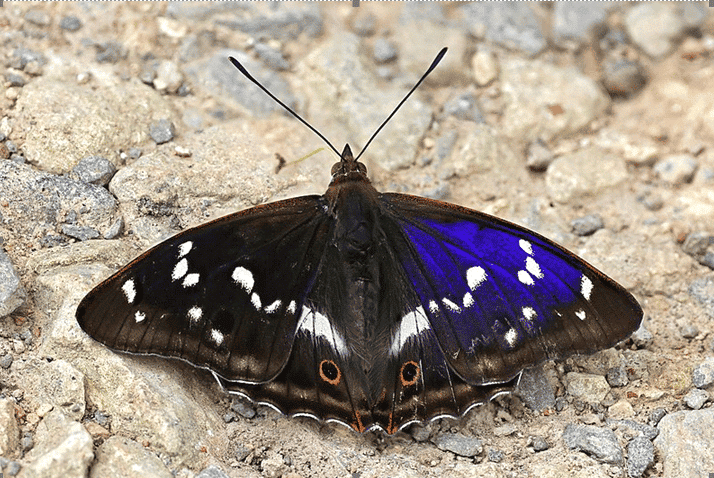
The purple emperor is a beautiful butterfly that is found in central southern, southeast, and eastern England. It avoids the hottest and coolest regions, sticking only to temperate regions.
Often referred to as ‘His Imperial Majesty, the butterfly is one of the most impressive purple animals, but elusive too. You’ll only see the emperor’s purple color from certain angled. Such elusive nature gave birth to its scientific name, Apatura iris. ‘Apatura’ is a Greek word that implies deception.
From the name ‘ emperor ‘ and ‘ His Imperial Majesty, ‘you can tell that it’s a male. The males and females have black wings. However, you’ll see a rich and iridescent purple color on those of the males at the right angle.
The purple emperor is the size of a bat, which makes it bigger than most butterflies. Rather than flit like most butterflies, they soar high up above middle-sized trees. You’re likely to see one between early July and early August.
There are two species of the purple emperor; one is the lesser purple emperor and the other is called the Fryer’s purple emperor. In both species, you’ll find a golden hue on their purple.
9. Purple Starling
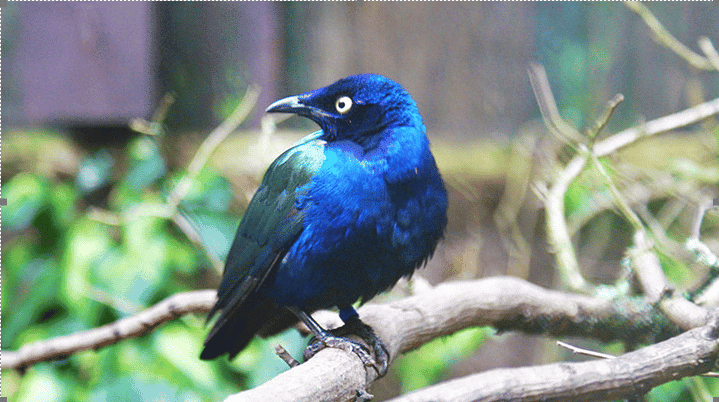
You’ll notice that most of the purple animals in the world are birds. The purple starling is one such bird, belonging to the starling family of birds. The purple starling is also known as the purple glosssy starling. The bird is large and has a short tail. More than just its purple color, the purple starling has a distinctive huge yellow-orange eye.
Scientifically known as Lamprotornis purpureus, they are usually found in flocks in savanna habitats ( mostly Africa ). They can also be found in a freshwater environment, shrublands, and anthropogenic biome.
Unlike the purple emperor, the purple starling’s male and female are alike. However, their young have duller purple and brown eyes. Other than their striking 22-23 cm length, the purple starling is very noisy. The bird is omnivorous, meaning it eats both plants ( fruits ) and animals ( insects ). Speaking of insects takes us to the third on the list.
8. Violet Ground Beetle

Violet is a darker shade of purple ( bluish-purple ). Therefore, in case you are wondering, the violet ground beetle is valid on this list. Found in gardens, meadows, woodland, heathland, or farmlands, these beetles are predators. They prey on slugs and other invertebrates that are smaller than they are. These beetles are nocturnal and will spend the day resting under shades like foliage and stones. They are widespread and reside anywhere that has grasslands, freshwater, farmlands, wetlands, and woodlands. You can see find them easily for most of the year. However, they may hibernate during cold periods.
There are two species of the violet ground beetle, and you can easily confuse them. One is the Carabus violaceus, which is more common and purple than the Carabus problematicus. The former favors gardens, meadows, and farmlands, while the latter loves woodland and heathland. Also, the violaceus are more common than the problematicus.
Both species have a metallic-purple color around the edges of their fused wings. These fused wings are known as elytra and offer the main difference between both species. Carabus problematicus’ elytra is more textured, with many ridges and dimples. Carabus violaceus’ elytra is smoother and has fewer ridges and dimples.
7. Orchid Dottyback
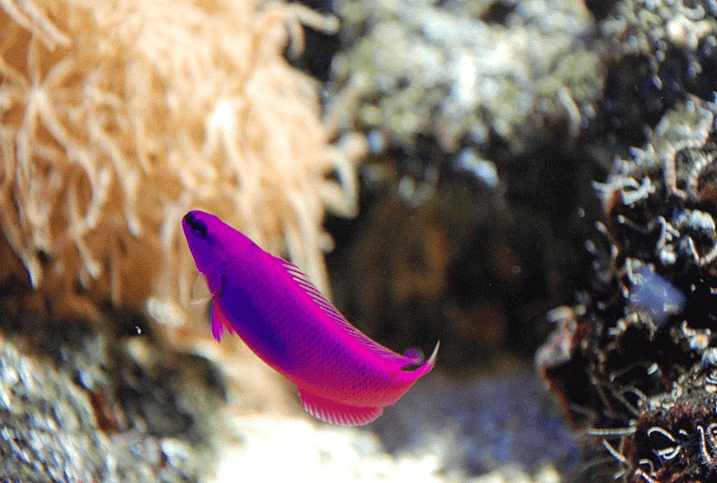
The orchid dottyback is also known as Fridman’s dottyback, Fridman’s pseudochromis, or purple dottyback. Their purple color is intense and beautiful. The 7cm-maximum-sized Orchid Dottyback is largely distributed in the Red Sea. They are the most sociable and peaceable of the dottyback species, with a distinctive hardiness and bold disposition.
However, like other dottybacks, they exhibit sexual dimorphism. Sexual dimorphism means that they are born a certain sex but can change to another. In the case of orchid dottybacks, they are born female and can change to male. However, they can’t change back when they become another sex.
The orchid dottyback is a common pet in aquariums. If you keep an orchid dottyback in an aquarium, ensure no timid fish are present. Timid fish are fish that can’t stand up to themselves. Dottybacks love feeding on those fish. It’s best to add them last to the aquarium. This will give the original fish present to claim their territory and stand up to the dottyback. However, dottybacks feed mostly on bristleworms, ornamental shrimps, and fanworms.
They love to live around vertical rocks. However, they don’t love being in groups. Therefore, if you want to have more than one in a tank, ensure the tank has broken views. Also, ensure the tank’s lid is tight because orchid dottybacks are jumpers.
6. Purple Starfish
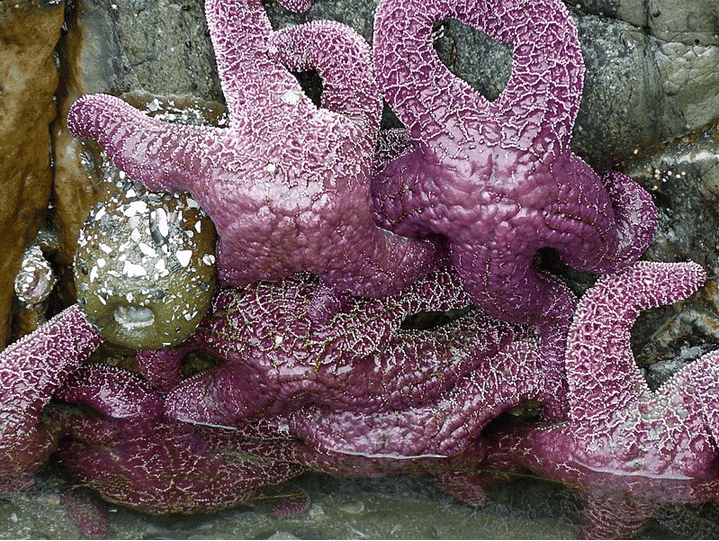
The purple starfish is also known as the purple sea star or ochre sea star. They are common in the rocky shorelines of the Pacific Ocean where they feed largely on shellfish. You’re most likely to find them hiding in rocks on the shorelines of Alaska and California.
The purple starfish is commonly purple in color, but there are a few, which are orange, yellow, or brown. In the same way, they commonly have five arms, but some may have three, four, or seven. The arms range in length from 10 – 25 cm and may weigh close to a pound. They are bulky and have many spines.
Sea creatures can’t tolerate high levels of oxygen. That’s why they live in water, which has lesser oxygen than land. However, the purple starfish is an exception. They can stay for as long as eight hours in high-oxygen-level areas. Therefore, they can survive in shallow waters. That’s why you’ll often find them at the edges of the ocean, where the waves and shore meet.
However, they love deeper waters and thrive best in them. When it gets colder, and during spawning, you’ll most likely find them in deeper waters. Spawning is the process by which the purple starfish produce offspring in water.
Spawning season for the purple starfish is from May to July. The male releases sperm, and the female releases eggs into the waters. Depending on how big the female is, she can produce up to 40 million eggs. The eggs and sperms meet on their own. This is sexual reproduction, but they can reproduce asexually as well.
The purple starfish is a carnivore. Its common diets include barnacles, clams, snails, mussels, and limpets. When it comes in contact with these preys, it’ll tear them open using tube-like structures at the end of its arms. When its preys are dead, it’ll extend its stomach into their shells and eat. The purple starfish’s stomach is also tube-like.
5. Indian Purple Frog
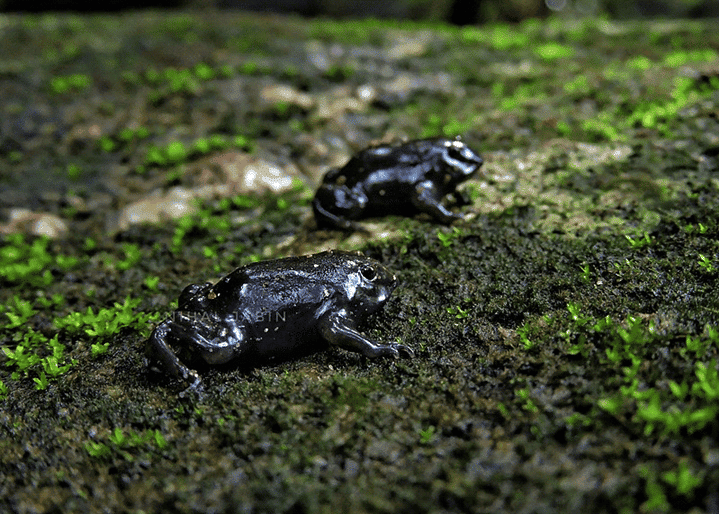
This purple frog is Indian because it’s found in the Western Ghats of southern India. It belongs to the family Nasikabatrachidae.
You’re unlike to see one even in their habitats. That’s is because they live underground for most of their lives. The only time they surface is when they want to mate. Their food is underground creatures like termites.
Because they hardly surface, most people in the world don’t know about them. It was first found in October 2003. Little knowledge of them encourages deforestation, which destroys their habitats. Hence, they are one of the endangered purple animals.
They look and sound strange. Their smooth deep purple skin covers a bloated body. Their head is small, and their faces have white snouts on them. They don’t croak like common frogs.
4. Purple Sea Urchins
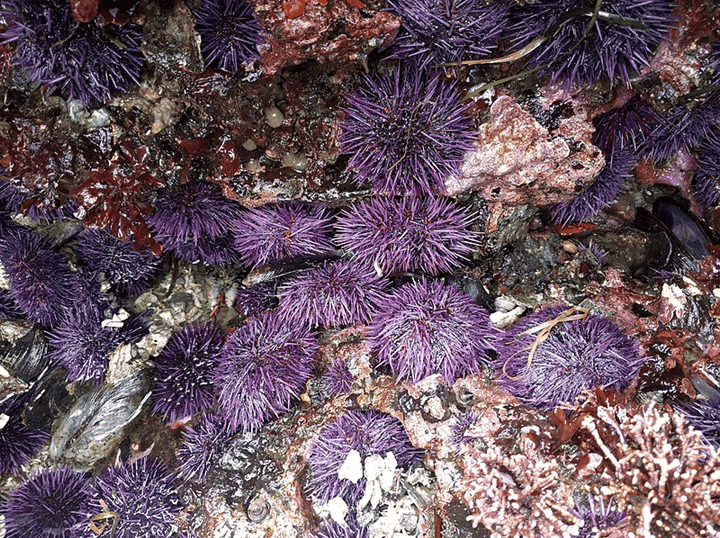
Also known as Pacific purple sea urchins, they live on the ocean floor of the Pacific.
Like other sea urchins, they have pincers and tube feet. They use their tube feet for breathing and moving along the seafloor. Their purple spines are what differentiates them from other sea urchins.
These spines use a ball-and-socket mechanism for movement. The spines are sharp to defend against protectors and are also used to secure food (primarily kelp).
They also have ‘Aristotle’s lanterns which are tooth-like plates around their mouths. With all these sharp features they possess, it is no wonder they’re aggressive.
3. Purple Firefish

The purple firefish is a saltwater species, a close cousin of the firefish, and has many other names. They include flame firefish, purple dartfish, decorated dartfish, decorated firefish, and fire goby.
It’s naturally white in color and sometimes a shade of yellow. However, they have deep purple hues at the fins and head. The purple firefish is no doubt one of the most beautiful purple animals in the world.
They are the center of attraction in most aquariums, despite living alone at the dark bottom of the tank. In fact, such a solitary life is their natural characteristic. They only come together to mate.
Although they’re relatively small, they’re hardy. They have a lifespan of three years that they spend feeding on tiny crustaceans and their larvae. They are primarily carnivores, but you can feed them zooplankton if you keep them as pets.
Naturally, they are natives of the tropic waters of the Indo-West Pacific. You’ll find that they display aggression towards their kind but are peaceful with others.
2. Violet Sea Snail
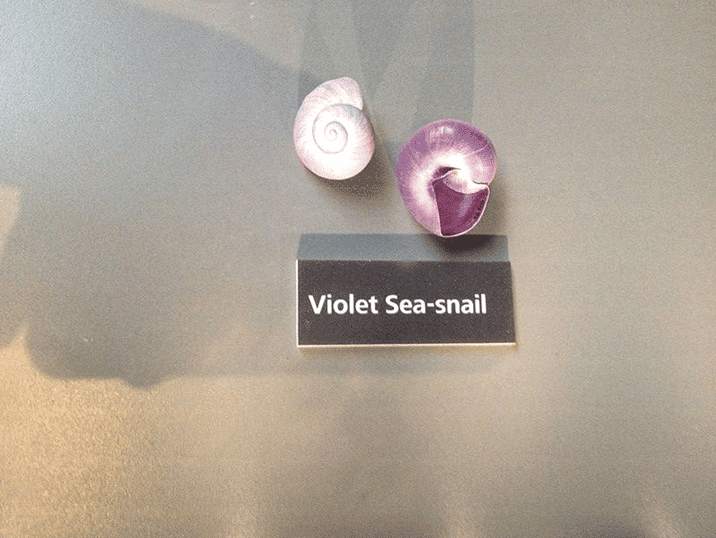
Also known as the bubble raft snail, the violet sea snail is often considered ‘ alien ‘. They are tropical species but can also be found in some parts of Europe.
When the larva becomes an adult, it produces bubble raft ( hence the name ). This bubble raft helps keep the snail afloat for the rest of its life, with its shell downwards. That is why they are ‘ alien ‘.
They feed on floating jellyfish as long as they are afloat. The sea snail will remain afloat unless it detaches from its bubble raft. If so, it’ll sink to the seabed where it will die.
1. Magnificent Sea Anemone
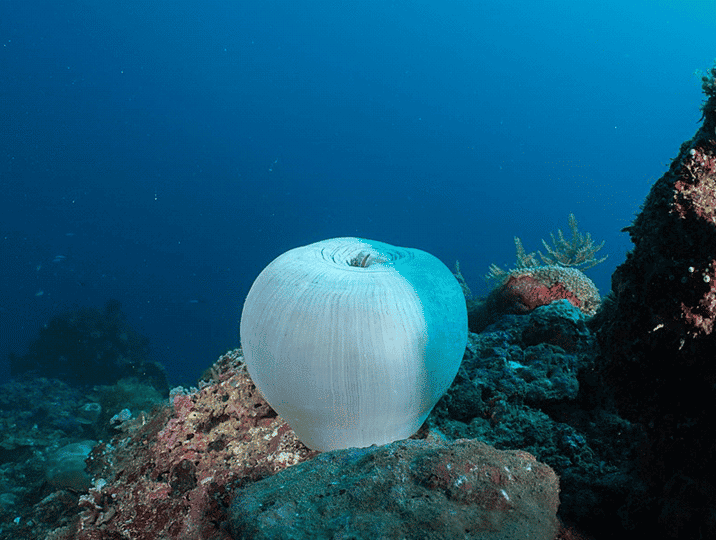
This massive purple animal is found only in the tropical regions of the Indo-Pacific ocean. The Indo-Pacific ocean includes the waters of South East Asia, the Western Pacific regions, and Northern Australia.
The magnificent sea anemone thrives best in warm water ( between 24 – 32 °C ). It can either exist in a colony or stand-alone, depending on the depth of water where it is found. Those that exist deeper in the water live in colonies.
The world doesn’t know how long they live in the wild. However, they stay up to 80 years in captivity, making them the longest-living purple animal in the world.
However, they live their entire lives in the polyp form. Polyp form is a non-motile cylindrical-shaped form common to the phylum Cnidaria. In this form, the organism exists inside a mucous membrane. It’s temporal for all other Cnidaria except the sea anemones.
The magnificent sea anemone has a pedal disc to anchor it to solid surfaces. It also has an oral disc that contains the mouth and tentacles. The oral disc is usually green, brown, or yellow.
Summary of 10 most exciting purple animals
We’ve come to the end of our list. You must agree that these animals are beautiful. If you love them, share and drop your comments below.
Here is a list of the brown animals and animals that start with n that you should definitely look at.
Join our Forum for free today!

- These are The 5 Largest Great White Sharks Ever Recorded - July 19, 2024
- The Surprising Benefits of Big Game Hunting - July 18, 2024
- $100k+ Hunting Experiences The Most Expensive Animals to Pursue - July 17, 2024

